Have you ever wondered what that exuberant scrambling vine growing against the northern face of the State Library is?
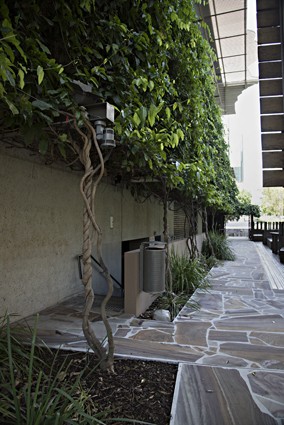
Image courtsey Josie Huang, State Library of Queensland
Its correct botanical name is Faradaya splendida (family Lamiaceae ). Faradaya after the English physicist Michael Faraday; splendida for the glossy sheen of its large dark- green leaves; Lamiaceae, curiously, because its flower structure conforms to that of the mint family.
Faradaya splendida is an evergreen, woody, twining native of Queensland’s tropical north, known for its stunning white fragrant blooms and vigorous growth, needing plenty of water, warmth and full sun to flourish. It’s also found in Papua New Guinea, Indonesia, Malaysia and the Solomon Islands, and the gardeners among you will be interested to know that it’s easily propagated from fresh seed or cuttings.
The abundant scented flowers, 6-7 cm across, last only a single day, but appear all year round apart from the colder winter months.
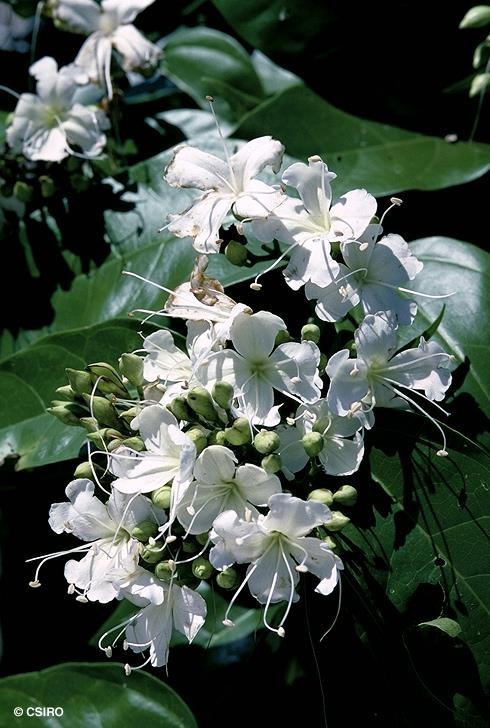
© CSIRO. Faradaya splendida leaves and flowers, reproduced with permission
Faradaya splendida is known by a string of common names – October Vine, October Glory, October Surprise, Glory Vine, Native Glory Vine, Potato Vine, Fragrant Faradaya; Indigenous language names include Garanggal (Cairns-Yarrabah), Buku (Tully River) and Koie-yan (Dunk Island). Naturalist Stanley Breeden in his Visions of a Rainforest quotes Robert Murray, a rainforest man of the Girramay clan, who adds another to this list: ‘Djungeen’.
For the Girramay, Faraday splendida is an ‘indicator’ plant, as after the flowers are spent, and its potato-like fruits have turned white and fallen to the ground in October, they know that the Bush Turkey nests will have eggs in them. This explains the presence of little bush turkey chicks currently running around in my own garden.
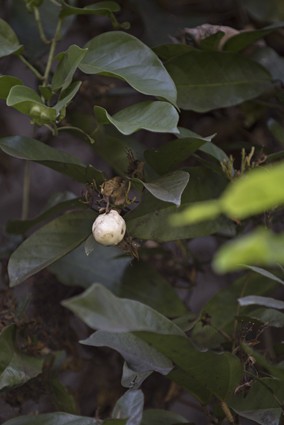
Faradaya splendida, image courtesy Josie Huang, State Library of Queensland
Interestingly, the bark of this vigorous creeper is rich with saponin, a toxin once used by Aborigines to stun and capture fish. Ted Banfield (1852 –1923) - journalist and author of Confessions of a Beachcomber - described this practice in his own eloquent description of the plant in his Tropic Days:
This is one of the most rampant and ambitious of the many vines of the jungle. It combines exceeding vigour with rare gracefulness. The leaves are a light glossy green, ovate, and often a foot long, while the flowers are pure white (resembling slightly the azalea, but free from its fragility), large, and with an elusive scent, sweet and yet indefinite. The fruit, smooth and of porcelain whiteness, varies in size and shape, and is said to be edible, though blacks ignore it. A large marble and an undersized hen’s egg may dangle together, or in company with others, from the topmost branches of some tall tree, which has acted as host to the clinging vine. The handsome but inconsiderate plant is turned from its purpose of lending fictitious and fugitive charms to quite commonplace but passive trees to the office of stupefying uncomplaining fish. But the element which holds such deadly enmity to the sense of the fish is not obtainable by the simple primary means successful with other plants. Indeed, the process is quite elaborate, and goes to prove that the Australian aboriginal has to his credit as a chemist the results of successful original research, and that he is also a herbalist from whom it is no condescension to learn. In this detail, at any rate, he is distinctly an accomplished person. Portions of the vine are cut into foot lengths; the outer layer of bark is removed and rejected, the middle layer alone being preserved. This is carefully scraped off and made up into shapely little piles on fresh green leaves. One might imagine that a black boy preparing the deadly “Koie-yan” was really playing at chemist’s shop with neat-handed scrupulousness. When a sufficiency is obtained it is rubbed on to stones previously heated by fire. The stones then being thrown into a creek or a little lagoon left by the receding tide, the poison becomes disseminated, with fatal effect to all fish and other marine animals.
Faradaya splendidaRoss Gelling, a Townsville horticulturist who writes for Subtropical Gardening Magazine writes that ‘under ideal conditions, within a season or two, it is not uncommon for this vine to completely cover a 30m tree three times over, with its woody twining mass. That being said, in a subtropical environment, lacking the warmth and endless water of its tropical lowland rain forest habitat, this beautiful specimen is quite a tame and well-behaved resident’.
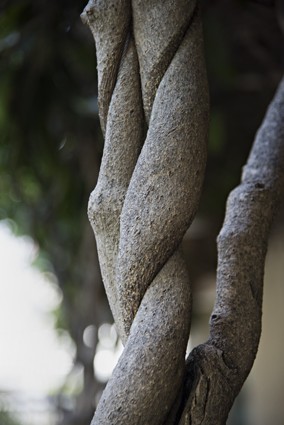
Faradaya splendida, image courtesy Josie Huang, State Library of Queensland
I’m not sure I agree with Ross, as our vine, planted in 2006 as part of the Millennium Arts Project redevelopment of the State Library building, has almost reached the top of the 15m wall, and will soon eclipse what’s left of the State Library of Queensland lettering.
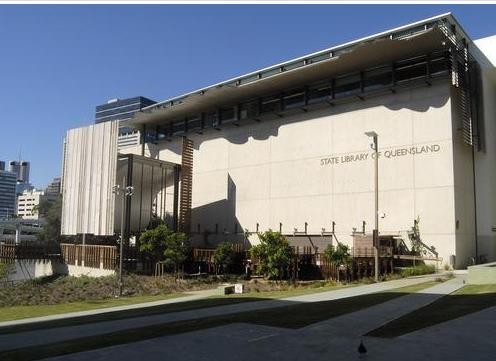
North-west wall of the State Library of Queensland, South Brisbane, 2006. John Oxley Library, State Library of Queensland, Image no. 7017-0001-0006, http://hdl.handle.net/10462/deriv/35467
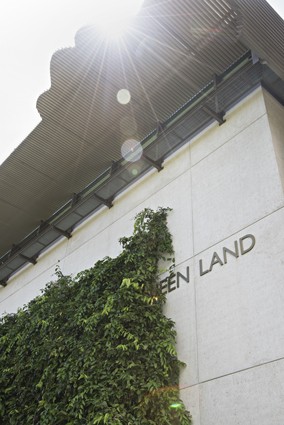
North-west wall of State Library of Queensland December 2016
Image courtesy Josie Huang, State Library of Queensland
Early description of Faradaya splendida
Faradaya splendida
"Genus exiimium ornavi nomine illustrissimi Michaelis Faraday. D.C.L., LL.D., Chemiiu in regio institute Britannias Professoris Fulleriani, philosophi per orbem celebrati."
‘Genus named after the illustrious Michael Faraday, Doctor of Civil Law, Fellow of the Royal Society, Fullerian Professor of Chemistry of the British Royal Institute, and world-celebrated philosopher’
You can read von Mueller’s formal account of the plant in his journal Fragmenta Phytographiae Australiae 1865 at the wonderful Biodiversity Heritage Library but you’ll have to brush off your Botanical Latin – the international language of the botanist used in descriptions of plants considered new to science:
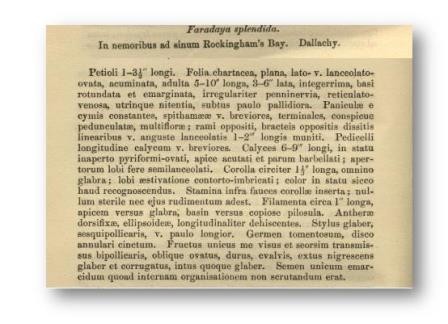
Source: Fragmenta Phytographiae Australiae vol 5 (1865) pp 21-2
The first part of the entry refers to the fact that Von Mueller’s specimens were collected in the rainforest at Rockingham Bay (Cardwell) by Scottish botanist John Dallachy, his friend and colleague at the Melbourne Botanic Gardens.
It was at von Mueller’s suggestion that Dallachy had joined the George Dalrymple exploring party in 1864 with the aim of forming a settlement at Rockingham Bay. Dallachy was so enchanted by the luxuriant flora of Far North Queensland that he never returned to Melbourne. He died in Cardwell in 1871.
Remarkably, Dallachy’s carefully-preserved specimens, brown with age, can still be seen at the National Herbarium of Victoria in Melbourne. This image is one of the three ‘types’ they hold for F. splendida collected by Dallachy.
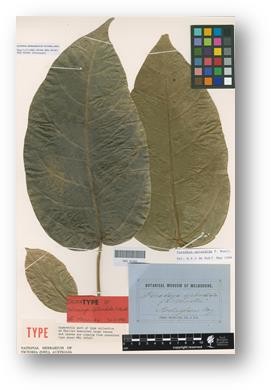
F. splendida collected by Dallachy.
Image reproduced with permission from the Royal Botanic Gardens, Victoria.
Another early description of the plant – in English - can be found in W.J. Hooker’s article ‘Faradaya splendida – Native of Queensland’ published in Curtis’s Botanical Magazine of August 1891 . Sir William Jackson Hooker was a leading botanist and first Director of the great Royal Botanic Gardens, Kew. Interestingly, he writes that their plant was sent from the Brisbane Botanical Gardens in 1879, which means it must have been sent by Walter Hill (another Scot) who had been Queensland's first Colonial Botanist and curator of the Brisbane Gardens from 1856-1881. Hooker notes its vigorous growth pattern:

Source: 'Faradaya splendida’. Curtis’s Botanical Magazine, vol. 117 ( 560), August 1891 Tab 7817 Sadly, I’m reliably informed that this Brisbane-born specimen is no longer extant, due to restoration works on the Kew Gardens Palm House in the 1980s.
Drawings and Illustrations of F. splendida, like this one accompanying the 1891 Hooker article can be found in various botanical journals:
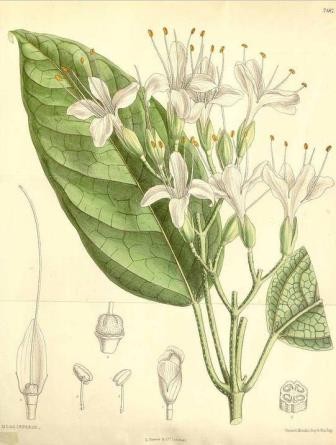
Illustration of 'Faradaya splendida’. Source: 'Faradaya splendida’. Curtis’s Botanical Magazine, vol. 117 ( 560), August 1891 Tab 7817 The vine was also painted by the diminutive Victorian flower artist, Ellis Rowan (1848-1922) who made several excursions to the north.
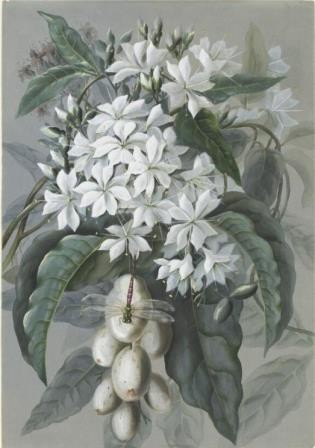
Ellis Rowan. Faradaya splendida F.Muell., family Lamiaceae, Queensland, c1891
Ellis Rowan Australian Collection, 275/891
National Library of Australia
http://nla.gov.au/nla.obj-138769669/view
Note Rowan’s insertion of the insect – a trademark employed in many of her paintings, added for artistic effect. Such flourishes are forbidden in the practice of botanical illustration, the main goal of which is botanical accuracy, rather than artistry, enabling exactitude in the identification of a plant from its leaves, stems, fruits etc.
Faradaya splendida is in fact host to a number of creatures, including the larvae of several species of butterfly found in Far North Queensland (Common Oak Blue, Common Tit; Pale Cillate-blue and Eone Blue). We have a family of possums living in our vine, and have even spotted snakes on occasion.
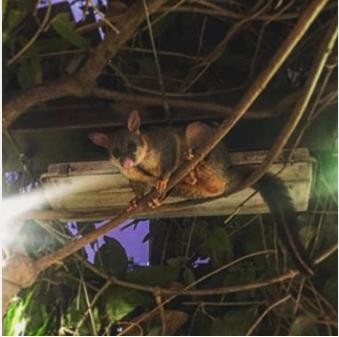
Possum in Faradaya splendida, State Library of Queensland
Image courtesy Amanda Hayman, SLQ Digital Exhibitions Program Officer, kuril dhagun
For those of you wanting to know more about this handsome Queensland vine, I’ve included some links below.
Further Reading
‘Faradaya splendida’ Subtropical Gardening Magazine
Australian Native Plants Society. Faradaya splendida http://anpsa.org.au/f-spl.html
Faradaya splendida F.Muell. Atlas of Living Australia http://bie.ala.org.au/species/http://id.biodiversity.org.au/node/apni/2899960#overview
Munir, A. A . 'A Taxonomic Revision of the Genus Faradaya F. Muell. Verbenaceae in Australia'. Journal of the Adelaide Botanic Gardens 10(2): 165-177 (1987) https://www.jstor.org/stable/23874064
Home, R.W. et al. (eds) Regardfully Yours. Selected Correspondence of Ferdinand von Mueller (Life and letters of Ferdinand von Mueller) Bern: Peter Lang, 1998-2002 http://onesearch.slq.qld.gov.au/SLQ:SLQ_PCI_EBSCO:slq_alma21123455770002061
De Kok, R.P.J, & Mabberley, D.J. ‘The Genus Faradaya’ Blumea Vol. 44 (2) 1999 pp321-342 http://repository.naturalis.nl/document/565885
McKay, Judith. Ellis Rowan A Flower-Hunter in Queensland. Brisbane: Queensland Museum, 1990 http://onesearch.slq.qld.gov.au/SLQ:SLQ_PCI_EBSCO:slq_alma21135653110002061
Fullerton, Patricia. The Flower Hunter Ellis Rowan. Canberra: National Library of Australia, 2002 http://onesearch.slq.qld.gov.au/SLQ:SLQ_PCI_EBSCO:slq_alma21115147070002061
Stearn, William T. Botanical Latin. History, Grammar, Syntax, Terminology and Vocabulary. 3rd ed. Revised. London: David & Charles, 1983 http://onesearch.slq.qld.gov.au/SLQ:SLQ_PCI_EBSCO:slq_alma21121833470002061
Stanley Breeden. Visions of a rainforest : a year in Australia's tropical rainforest / text by Stanley Breeden ; East Roseville, N.S.W : Simon & Schuster Australia | 1992 http://onesearch.slq.qld.gov.au/SLQ:SLQ_PCI_EBSCO:slq_alma21131518250002061
Biodiversity Heritage Library http://www.biodiversitylibrary.org/
Jenny Freeman
Librarian, Information Services
Comments
Your email address will not be published.
We welcome relevant, respectful comments.